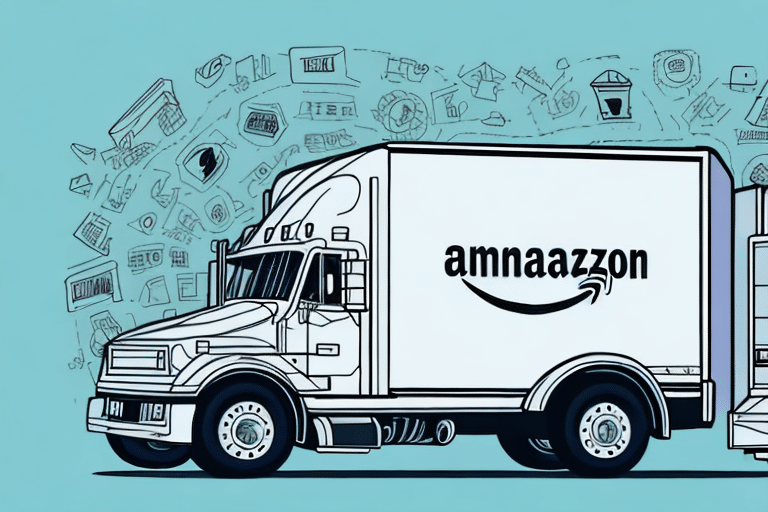Amazon, the world's largest online retailer, has revolutionized the shipping industry over the years. Starting as an online bookstore in 1994, Amazon has diversified and expanded its operations to include a wide array of products and services. In this article, we will explore the timeline of Amazon's shipping industry evolution and the significant milestones achieved in reshaping the shipping industry.
Amazon's early days in shipping
When Amazon first started, it used existing shipping carriers such as UPS and FedEx to deliver books to customers. In 1997, Amazon opened its first fulfillment center, where it stored products on behalf of third-party retailers, managed inventory, and shipped to customers directly. Amazon's fulfillment network has grown tremendously since then, with more than 110 fulfillment centers worldwide.
As Amazon's business expanded beyond books, the company began to experiment with new shipping methods. In 2005, Amazon launched Amazon Prime, a subscription service that offered free two-day shipping on eligible items. This service was a game-changer for the company, as it incentivized customers to shop more frequently and purchase more items at once.
Today, Amazon continues to innovate in the shipping and logistics space. The company has invested heavily in robotics and automation to improve efficiency in its fulfillment centers, and has even explored the use of drones for last-mile delivery. With its vast network of warehouses and delivery partners, Amazon has become a major player in the global shipping industry.
How Amazon's shipping industry has evolved over time
Since its early days, Amazon has been experimenting with different shipping methods to enhance customer satisfaction. In 2005, Amazon launched the Amazon Prime service, offering two-day delivery to customers who pay an annual fee. Later, Amazon introduced Same-Day and One-Day delivery options, respectively, in specific regions. In 2013, Amazon became the first retailer to offer Sunday delivery through a partnership with the US Postal Service.
In recent years, Amazon has continued to innovate its shipping industry by investing in its own delivery network. In 2015, the company launched Amazon Flex, a program that allows individuals to deliver packages using their own vehicles. In 2016, Amazon Air was introduced, which is a fleet of cargo planes that transport packages across the country. Additionally, Amazon has been testing drone delivery in select areas, with the goal of delivering packages in 30 minutes or less.
The impact of Amazon's shipping on the retail industry
Amazon's shipping practices have disrupted the retail industry and have influenced customers' purchasing behavior significantly. Amazon's fast delivery options and competitive pricing have forced other retailers to improve their shipping practices to remain competitive. The shipping industry has also seen an increase in demand with the rise of Amazon.
Furthermore, Amazon's shipping practices have also contributed to the growth of e-commerce. With the convenience of online shopping and fast delivery options, more and more customers are turning to e-commerce platforms like Amazon to make their purchases. This has led to a decline in foot traffic for brick-and-mortar stores, causing many retailers to shift their focus to online sales.
However, Amazon's shipping practices have also raised concerns about the environmental impact of fast and frequent deliveries. The increase in shipping volume has led to a rise in carbon emissions and packaging waste. As a result, Amazon has implemented initiatives to reduce its carbon footprint, such as using electric delivery vehicles and implementing sustainable packaging options.
The role of technology in Amazon's shipping success
Technology plays a significant role in Amazon's shipping operations. With the help of advanced algorithms and machine learning models, Amazon can optimize its delivery processes, minimize delivery times, and reduce shipping costs. Amazon also uses technology to track delivery vehicles in real-time, manage inventory levels, and predict demand and supply.
In addition to these benefits, Amazon's use of technology has also allowed for greater transparency and accountability in their shipping operations. Customers can track their packages in real-time, receive notifications about delivery times, and provide feedback on their delivery experience. This level of transparency has helped to build trust with customers and improve overall satisfaction.
Furthermore, Amazon's technology has enabled them to expand their shipping capabilities beyond traditional methods. They have experimented with drone delivery, which has the potential to significantly reduce delivery times and costs in certain areas. Additionally, Amazon has developed partnerships with other companies to utilize their shipping networks and infrastructure, further expanding their reach and capabilities.
How Amazon's shipping has changed consumer expectations
Amazon has raised the bar for customer expectations, not just in terms of delivery times but also in terms of transparency and convenience. The ability to track shipments in real-time and receive alerts about delivery times has become an expectation for most customers. Amazon's use of technology to improve the shipping experience has set a new standard that other retailers now strive to match.
Furthermore, Amazon's introduction of same-day and next-day delivery options has also changed the way consumers shop online. Customers now expect faster delivery times and are willing to pay extra for the convenience. This has put pressure on other retailers to offer similar options, or risk losing customers to Amazon.
Amazon's partnerships with major carriers and logistics companies
Amazon has formed strategic partnerships with major carriers, including UPS, FedEx, and the US Postal Service, to leverage their delivery networks. Amazon has also invested heavily in building its logistics network, including a fleet of airplanes and delivery trucks. Amazon's investments in logistics have helped improve delivery times and reduce shipping costs.
In addition to its partnerships with major carriers and logistics companies, Amazon has also developed its own delivery service, Amazon Flex. This service allows individuals to sign up as independent contractors and deliver packages using their own vehicles. Amazon Flex has helped the company expand its delivery capabilities and reach more customers in a cost-effective manner.
Amazon's expansion into air cargo and delivery drones
In recent years, Amazon has invested in expanding its logistics network further. One significant investment involves leasing airplanes to create an air cargo network to support its delivery operations. Amazon has also experimented with delivery drones, aiming to reduce delivery times and costs even further. Although delivery drones are not yet widespread, Amazon is actively working on regulatory approvals to increase their use.
Amazon's expansion into air cargo and delivery drones has not only improved its delivery operations but has also created new job opportunities. The company has hired thousands of pilots, mechanics, and other aviation professionals to support its air cargo network. Additionally, Amazon has invested in training programs to help employees develop the skills needed to operate and maintain delivery drones. This investment in human capital has not only benefited Amazon but has also contributed to the growth of the aviation industry as a whole.
The challenges and controversies surrounding Amazon's shipping practices
Despite the benefits of Amazon's shipping practices, they have faced criticism and controversy, especially in terms of worker treatment and environmental impact. Reports of poor working conditions in Amazon's fulfillment centers have raised concerns about worker welfare. Amazon is also facing scrutiny for its environmental impact, with concerns about packaging waste and the carbon footprint of their delivery network.
In addition to worker treatment and environmental impact, Amazon's shipping practices have also been criticized for their impact on small businesses. Some argue that Amazon's dominance in the e-commerce market gives them an unfair advantage, as they are able to negotiate lower shipping rates and offer faster delivery times than smaller competitors. This has led to calls for increased regulation and antitrust action against the company.
A comparison of Amazon's shipping to other major retailers
Amazon's shipping practices have set a new standard for retailers worldwide. Compared to other major retailers, Amazon's delivery times are some of the fastest, and their shipping practices allow customers to track their shipments easily. Other retailers have started to adopt similar practices, although Amazon remains ahead in terms of innovation and adoption of technology.
The future of Amazon's shipping industry
The future of Amazon's shipping industry is exciting and full of opportunities. Amazon is continually investing in technology and logistics to improve delivery times and reduce shipping costs further. Amazon's expansion into air cargo and delivery drones has the potential to revolutionize delivery options further. It's safe to say that Amazon's shipping industry will continue to set the standard for the retail industry and the shipping industry at large.
One of the most significant advantages of Amazon's shipping industry is its ability to collect and analyze vast amounts of data. By tracking customer behavior and delivery patterns, Amazon can optimize its shipping routes and delivery times, reducing costs and improving efficiency. Additionally, Amazon's use of artificial intelligence and machine learning algorithms can help predict demand and adjust inventory levels accordingly, further streamlining the shipping process. With these advanced technologies, Amazon's shipping industry is poised to continue its growth and dominance in the retail industry.
How COVID-19 has affected Amazon's shipping operations
The COVID-19 pandemic has had a significant impact on Amazon's shipping operations. With stay-at-home orders in place, online shopping has seen a significant uptick, leading to increased demand for Amazon's shipping services. Amazon has had to adjust its delivery practices to meet the increased demand while ensuring the safety of its employees. Shipping times have been impacted, and Amazon has had to prioritize essential items such as household goods and medical supplies.
The environmental impact of Amazon's shipping
Amazon's shipping practices have a significant environmental impact, particularly in terms of carbon emissions and packaging waste. Amazon has recently committed to being carbon-neutral by 2040, and is investing in technology to reduce emissions from its logistics network. Amazon has also been working to reduce packaging waste, introducing packaging design guidelines and incentivizing customers to recycle packaging materials.
How customer feedback has influenced Amazon's shipping policies
Customer feedback plays a crucial role in shaping Amazon's shipping policies. Amazon encourages customers to provide feedback on their shipping experience and uses that feedback to identify areas for improvement. Customers' feedback has helped Amazon prioritize faster delivery times and introduced better tracking options. Amazon's focus on customer satisfaction has driven the company's continued investment in improving its shipping operations.
The role of data analytics in optimizing Amazon's shipping network
Amazon uses data analytics to optimize its shipping network continually. By analyzing data on delivery times, shipping costs, product demand, and other factors, Amazon can identify areas for improvement and make data-driven decisions to enhance its shipping operations. Data analytics plays a critical role in ensuring that Amazon can meet its customers' high expectations for shipping times and cost.
In conclusion, Amazon's shipping industry has undergone significant evolution over the years. Amazon has transformed the retail industry and the shipping industry worldwide through innovation and investment in technology and logistics. The future of Amazon's shipping industry is exciting, with continued investment in technology and innovation. Amazon's commitment to customer satisfaction and reducing environmental impact ensures that its shipping practices will continue to evolve and set the standard for the industry.






















